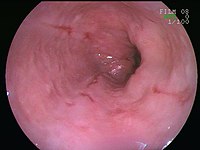
Photo from wikipedia
Purpose Lymphoid hyperplasia can be an important mimicker of acute appendicitis by creating a non-compressible appendix more than 6 mm in diameter. The aim of this study was to evaluate… Click to show full abstract
Purpose Lymphoid hyperplasia can be an important mimicker of acute appendicitis by creating a non-compressible appendix more than 6 mm in diameter. The aim of this study was to evaluate methods of distinguishing lymphoid hyperplasia and appendicitis on the basis of sonography, lamina propria thickness, and Alvarado scoring. Methods This retrospective study included 259 patients (142 appendicitis, 117 lymphoid hyperplasia). The US (ultrasound) reports of the patients were reviewed and the maximum diameter of the appendix, the presence or absence of increased echogenicity of the surrounding pericaecal fat, local fluid collection, the presence of reactive lymph nodes in the periappendiceal area, and mural hyperemia within the appendix were recorded. Results The use of additional sonographic criteria, lamina propria thickness (≤1 mm is indicative for appendicitis), or Alvarado scoring (>6 mm is indicative for appendicitis) provided a true-positive diagnosis for acute appendicitis. Conclusion The presence of local fluid collection in the periappendiceal area and a lamina propria thickness ≤ 1 mm are the most successful parameters for distinguishing appendicitis from lymphoid hyperplasia.
Journal Title: Canadian Association of Radiologists Journal
Year Published: 2019
Link to full text (if available)
Share on Social Media: Sign Up to like & get
recommendations!